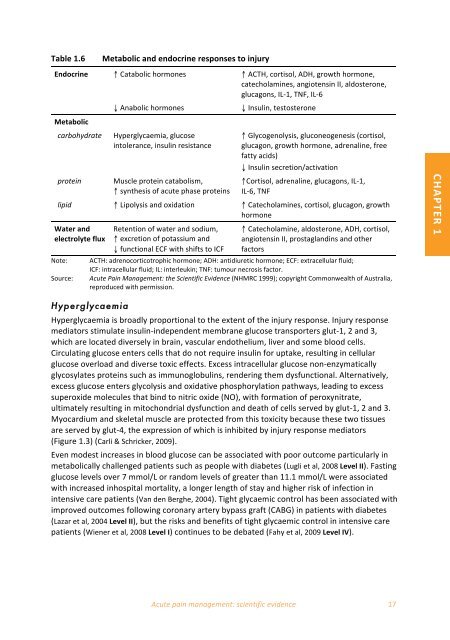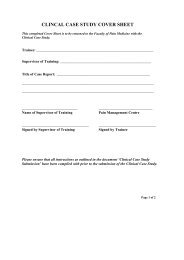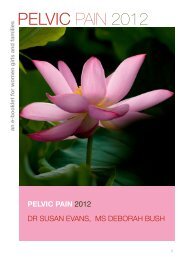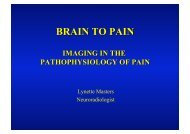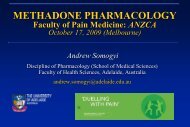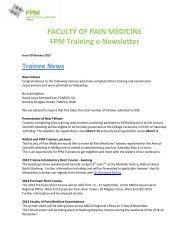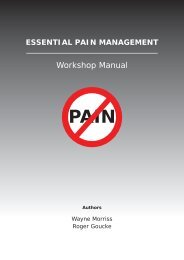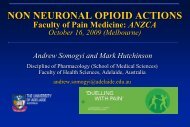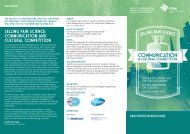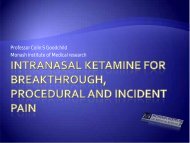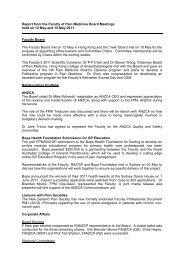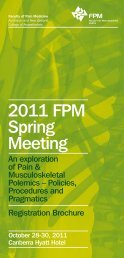Acute Pain - final version - Faculty of pain medicine - Australian and ...
Acute Pain - final version - Faculty of pain medicine - Australian and ...
Acute Pain - final version - Faculty of pain medicine - Australian and ...
Create successful ePaper yourself
Turn your PDF publications into a flip-book with our unique Google optimized e-Paper software.
<br />
<br />
Table 1.6 <br />
Metabolic <strong>and</strong> endocrine responses to injury <br />
Endocrine ↑ Catabolic hormones ↑ ACTH, cortisol, ADH, growth hormone, <br />
catecholamines, angiotensin II, aldosterone, <br />
glucagons, IL‐1, TNF, IL‐6 <br />
↓ Anabolic hormones ↓ Insulin, testosterone <br />
Metabolic <br />
carbohydrate Hyperglycaemia, glucose <br />
intolerance, insulin resistance <br />
protein Muscle protein catabolism, <br />
↑ synthesis <strong>of</strong> acute phase proteins <br />
↑ Glycogenolysis, gluconeogenesis (cortisol, <br />
glucagon, growth hormone, adrenaline, free <br />
fatty acids) <br />
↓ Insulin secretion/activation <br />
↑Cortisol, adrenaline, glucagons, IL‐1, <br />
IL‐6, TNF <br />
lipid ↑ Lipolysis <strong>and</strong> oxidation ↑ Catecholamines, cortisol, glucagon, growth <br />
hormone <br />
Water <strong>and</strong> <br />
electrolyte flux <br />
Note: <br />
Source: <br />
Retention <strong>of</strong> water <strong>and</strong> sodium, <br />
↑ excretion <strong>of</strong> potassium <strong>and</strong> <br />
↓ functional ECF with shifts to ICF <br />
↑ Catecholamine, aldosterone, ADH, cortisol, <br />
angiotensin II, prostagl<strong>and</strong>ins <strong>and</strong> other <br />
factors <br />
ACTH: adrenocorticotrophic hormone; ADH: antidiuretic hormone; ECF: extracellular fluid; <br />
ICF: intracellular fluid; IL: interleukin; TNF: tumour necrosis factor. <br />
<strong>Acute</strong> <strong>Pain</strong> Management: the Scientific Evidence (NHMRC 1999); copyright Commonwealth <strong>of</strong> Australia, <br />
reproduced with permission. <br />
CHAPTER 1 <br />
Hyperglycaemia<br />
Hyperglycaemia is broadly proportional to the extent <strong>of</strong> the injury response. Injury response <br />
mediators stimulate insulin‐independent membrane glucose transporters glut‐1, 2 <strong>and</strong> 3, <br />
which are located diversely in brain, vascular endothelium, liver <strong>and</strong> some blood cells. <br />
Circulating glucose enters cells that do not require insulin for uptake, resulting in cellular <br />
glucose overload <strong>and</strong> diverse toxic effects. Excess intracellular glucose non‐enzymatically <br />
glycosylates proteins such as immunoglobulins, rendering them dysfunctional. Alternatively, <br />
excess glucose enters glycolysis <strong>and</strong> oxidative phosphorylation pathways, leading to excess <br />
superoxide molecules that bind to nitric oxide (NO), with formation <strong>of</strong> peroxynitrate, <br />
ultimately resulting in mitochondrial dysfunction <strong>and</strong> death <strong>of</strong> cells served by glut‐1, 2 <strong>and</strong> 3. <br />
Myocardium <strong>and</strong> skeletal muscle are protected from this toxicity because these two tissues <br />
are served by glut‐4, the expression <strong>of</strong> which is inhibited by injury response mediators <br />
(Figure 1.3) (Carli & Schricker, 2009). <br />
Even modest increases in blood glucose can be associated with poor outcome particularly in <br />
metabolically challenged patients such as people with diabetes (Lugli et al, 2008 Level II). Fasting <br />
glucose levels over 7 mmol/L or r<strong>and</strong>om levels <strong>of</strong> greater than 11.1 mmol/L were associated <br />
with increased inhospital mortality, a longer length <strong>of</strong> stay <strong>and</strong> higher risk <strong>of</strong> infection in <br />
intensive care patients (Van den Berghe, 2004). Tight glycaemic control has been associated with <br />
improved outcomes following coronary artery bypass graft (CABG) in patients with diabetes <br />
(Lazar et al, 2004 Level II), but the risks <strong>and</strong> benefits <strong>of</strong> tight glycaemic control in intensive care <br />
patients (Wiener et al, 2008 Level I) continues to be debated (Fahy et al, 2009 Level IV). <br />
<strong>Acute</strong> <strong>pain</strong> management: scientific evidence 17


